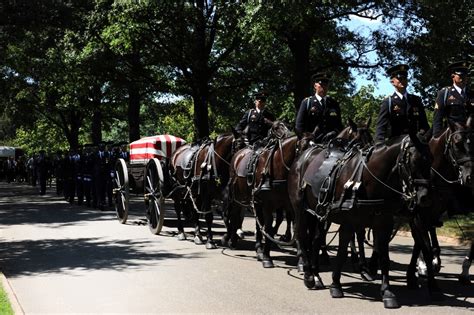3d U.S. Infantry Regiment (The Old Guard) – Caisson Platoon
Yesterday, I posted about the guards at the Tomb of The Unknown. I neglected to mention they are members of the 3d U.S. Infantry Regiment (The Old Guard)
The Old Guard has several speciality platoons. Today’s offering is on the Caisson Platoon.
https://oldguard.mdw.army.mil/specialty-platoons/caisson
Caisson
The silence of the procession is broken only by the rhythmic clip-clop of the seven handsome horses. Astride four of the horses, Soldiers sit ramrod straight. The horses, head erect, bodies taut and controlled, seem to imitate the solemn military bearing of the men and women who sit quietly in the saddles.
Six of the horses pull a flag draped casket on a black artillery caisson. Both Soldiers and horses are conscious that this is no ordinary ride through a cool, shady country lane. They have the honor of carrying a comrade for his last ride to Arlington National Cemetery, where he will rest in peace with other honored dead.
The solemn dignity which the riders and horses lend to this ceremony is neither accidental nor instinctive. Soldiers and horses train constantly for this duty. They are members of the Caisson platoon of the 3d United States Infantry “The Old Guard.”
Most of these men and women come to Ft. Myer, Virginia not as expert horseman, but as trained infantrymen, skilled in their individual fields and tactically proficient. A new Soldier on this team must undergo rigorous training on a riding style the Army hasn’t used anywhere else since 1948. In addition to caring for the horses, the Soldiers must learn to ride in the erect posture of solemn military attention and sitting in a McClellan saddle. In addition to maintaining the ceremonial uniform of an Old Guard Soldier, the Caisson Soldiers must learn to use, clean and maintain ceremonial tack and harness that is unique to their mission in Arlington National Cemetery. Because of this extensive equine training and experience, the Army has labeled the Caisson Soldiers with the Additional Skill Identifier D2 – Army Horseman.
The horses come to the Old Guard primarily from Illinois, Virginia, Texas and Maryland, as well as other states.
Although they are normally “saddle broken” before their arrival at Joint Base Myer-Henderson Hall, they require extensive additional training to work with the caisson. Consequently, horse and rider drill, train and live together until both are deemed qualified to accomplish their mission.
The caissons were built in 1918, and used for 75mm cannons. They were originally equipped with ammunition chests, spare wheels, and tools used for the cannons. Today these have been removed and replaced with the flat deck on which the casket rests.
The six horses which pull the caisson through the quiet lanes of Arlington National Cemetery are matched gray or black. They are paired into three teams – the lead team is in front, the swing team follows, and nearest the caisson is the wheel team. Although all six animals are saddled, only those on the left have mounted riders. This is a tradition which began in the early horse-drawn artillery days when one horse of each team was mounted while the other carried provisions and feed.
In addition to their duties in military funerals, the Caisson Platoon participates in numerous historic pageants performed by the Old Guard, among these are “Spirit of America,” and “Twilight Tattoo.” The Caisson Platoon has been honored by inclusion in Presidential Inaugural Parades, and has participated in various other historic events in the greater Military District of Washington, D.C.
THE RIDERLESS HORSE
One of the oldest and most evocative of military traditions in a full honor funeral is that of the riderless, caparisoned horse. The horse is led behind the caisson wearing an empty saddle with the rider’s boots reversed in the stirrups, indicating the warrior will never ride again.
Tradition allows a caparisoned horse to follow the casket of any Army or Marine Corps commissioned officer holding the rank of Colonel or above. Presidents of our nation, as Commander in Chief, are accorded the same honor. Over the years millions have witnessed caissons bearing the flag draped caskets of Franklin D. Roosevelt, Herbert Hoover, Douglas MacArthur, John F. Kennedy, Dwight D. Eisenhower, and Lyndon B. Johnson. In each ceremony the caisson was followed by the caparisoned horse.
BLACK JACK
The Caisson Platoon has been the home of the Army’s oldest and most famous horse – “Black Jack,” foaled January 19, 1947, and coming to Ft. Myer from Fort Reno, Oklahoma, on November 22nd, 1952. “Black Jack” had the honor of being named after General of the Armies John J. “Black Jack” Pershing.
“Black Jack” was the last of the Quartermaster – issue horses branded with the Army’s U.S. brand (on the left shoulder} and his Army serial number 2V56 (on the left side of his neck).
“Black Jack” had taken part not only in funerals of Presidents John F. Kennedy, Herbert Hoover, Lyndon B. Johnson, and General Douglas MacArthur. but literally thousands of others in Arlington Cemetery during his 24 years of service with the Old Guard.
“Black Jack” ended his dedicated, dignified military career on February 6, 1976, and is buried on the parade ground of Fort Myer’s Summerall Field.
